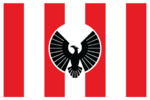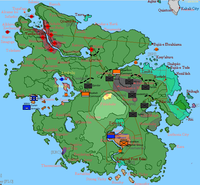Trans-Euran Command

|
|
| Active: | 1646–the present |
| In use by: | |
| Allegiance: | |
|
| |
| Type: | Command |
| Size: | 2,490,376 |
| Nickname: | Desert Rats |
|
| |
| Generalissimo: | Giakoumis II |
| Conflicts & Deployments | |
The Trans-Euran Command is a Constancian-led continental theatre command established by the SANE alliance of Constancia, Natopia, Shireroth and, formerly, the Empire of the Alexandrians. A multinational force, it is commanded by the Marshal of the Imperial Constancian Armed Forces, who was in turn given the concurrent Imperial Republic rank of Magister-Generalissimus, a special rank reserved only for the senior most Shirerithian Imperial Army officer in theatre.
Contributing forces
The main theatre-level formation available to the Trans-Euran Command, the Euranikon Omáda Lávaron (Euran Banner Group) is formed from units contributed by the Imperial Constancian Armed Forces and the Euran Expeditionary Forces formed overwhelmingly of Shirerithian auxiliaries with some naval and air force personnel attached. Although the Natopian contribution was comparatively small, they nonetheless provided personnel for crucial niche roles in the merchant fleet, responsible for keeping the Constancian cities in the Gulf of Aqaba fed, and the aerospace forces, as well as in sustaining certain niche high-tech capabilities beyond the skill of native Euran forces to maintain.
As the largest contributing force, in terms of headcount, the Imperial Constancian Armed Forces provides the commander-in-chief for the Trans-Euran Command and exercises command and control over allied forces deployed in theatre. Owing however to the degraded condition of the industrial base of Constancia, and the limited capacity of its economy, the Trans-Euran Command has remained heavily reliant upon material support delivered via the allocations system of the Allied Production Matrix.
National Contributions
| Contributing National Force | Allocation (% of Contributing National Force) |
Lead Nation |
|---|---|---|
| 80% | ||
| 5% | ||
| 40% | ||
| 100% | ||
| 90% |
Attached formations
Organisation
The organisational structure of the Trans-Euran Command is based around formations assigned from and led by the Imperial Constantinian Armed Forces (ICAF), with Aldurian units beginning to integrate into a combined command structure from 1681 AN onwards.
Order of Battle

 Trans-Euran Command
Trans-Euran Command
 Chief of Staff
Chief of Staff
- Committee of Euran Salvation
- Mehrshahr Special Economic Zone
- Military and Intelligence Cooperation Committee of the Euran Economic Union
- Grand Commissariat of Eura and Corum
- General Inspectorate of Eura and Corum
- Personnel Directorate
- Intelligence Directorate
 Independent Brigade for Radio-intercept and Radio-technical Reconnaissance
Independent Brigade for Radio-intercept and Radio-technical Reconnaissance /
/ Main Department of Political Warfare
Main Department of Political Warfare
- Operations Directorate
- Planning Directorate
- Information Directorate
- Committee of Euran Salvation
 Constancian Expeditionary Force (501st Army), at Arâk
Constancian Expeditionary Force (501st Army), at Arâk
 Sóma Syndyasménon Óplon "Γ" (Combined Arms Corps "Gamma"), at Astérpolis
Sóma Syndyasménon Óplon "Γ" (Combined Arms Corps "Gamma"), at Astérpolis Sóma Syndyasménon Óplon "Δ" (Combined Arms Corps "Delta"), at Ithonion
Sóma Syndyasménon Óplon "Δ" (Combined Arms Corps "Delta"), at Ithonion Constancian Foreign Legion, at Arâk
Constancian Foreign Legion, at Arâk Black Banner Fleet
Black Banner Fleet Expeditionary Air Group
Expeditionary Air Group
 Aqaba Banner Command
Aqaba Banner Command
 Sóma Syndyasménon Óplon "Ε" (Combined Arms Corps "Epsilon"), at Aqabah
Sóma Syndyasménon Óplon "Ε" (Combined Arms Corps "Epsilon"), at Aqabah 504th Army (Prosgeiosi Basileus)
504th Army (Prosgeiosi Basileus) 505th Army (Aqaba Province)
505th Army (Aqaba Province)
 512th Army (Oportia, Zeed)
512th Army (Oportia, Zeed)
 Aqaba Banner Fleet (The Gulf Fleet)
Aqaba Banner Fleet (The Gulf Fleet)
 Aqaba Banner Air Group
Aqaba Banner Air Group
 Corum Command
Corum Command
 Nivardom Banner Command
Nivardom Banner Command
 Sóma Syndyasménon Óplon "Ζ" (Combined Arms Corps "Zeta"), at Nivardom
Sóma Syndyasménon Óplon "Ζ" (Combined Arms Corps "Zeta"), at Nivardom 506th Army (Molivadia Province)
506th Army (Molivadia Province)
- 1st Vanguard Corps
- Elpída Corps
- Madilah Corps
- Peirateia Corps
 507th Army (Nivardom Province)
507th Army (Nivardom Province)
- Delta Corps
- Gamma Corps
- Zeta Corps
 508th Army (Raspur Khanate)
508th Army (Raspur Khanate)
- Mitra Corps
- Raspur Corps
- Varaz Corps
 509th Army (Suren Confederacy)
509th Army (Suren Confederacy)
 NAX Advisory Mission
NAX Advisory Mission- I Corps
- II Corps
- III (Reserve) Corps
 Vipia Corps
Vipia Corps
 510th Army (Shahzamin Province)
510th Army (Shahzamin Province) 4th Fleet Command (Béihagh)
4th Fleet Command (Béihagh) Nivardom Banner Fleet (The Slave Fleet)
Nivardom Banner Fleet (The Slave Fleet) Nivardom Banner Air Group
Nivardom Banner Air Group
 Susa Banner Command
Susa Banner Command
 511th Army (Razjania Province)
511th Army (Razjania Province) 513th Army (Alduria)
513th Army (Alduria)
 I (Alduria) CAC
I (Alduria) CAC
 1st Air Fleet
1st Air Fleet 2nd Federal Air Defence Wing
2nd Federal Air Defence Wing Euran Fleet
Euran Fleet
Leadership
| № | Portrait | Officeholder | Took office | Left office |
|---|---|---|---|---|
| Chiefs of Staff | ||||
| 1 |  |
George Maniakes | 1646 | 36.XV.1698 AN |
| Position vacant – 1699 War of the Officers | 1.I.1699 AN | 1.VII.1699 AN | ||
| 2 | Konstantin Moudros | 1.VII.1699 AN | 6.XI.1699 AN | |
| Position vacant – 1699 War of the Officers | 6.XI.1699 AN | 9.XV.1699 AN | ||
| 3 | Abeiron Maniakes | 9.XV.1699 AN | IX.1703 AN | |
| Position vacant – War for Rosamund's Honor | IX.1703 AN | 18.XIV.1706 AN | ||
| 4 |  |
Esmeralda al-Osman | 18.XIV.1706 AN | 13.XI.1743 AN |
| Supreme Generalissimo of Euran Forces | ||||
| 5 |  |
Giakoumis II | 13.XI.1743 AN | |
| № | Portrait | Officeholder | Took office | Left office |
|---|---|---|---|---|
| 1 |  |
Prince Iñigo | 16.IV.1733 AN | 13.XI.1743 AN |
| 2 |  |
Stratárchis Periklês Metaxas | 13.XI.1743 AN |
Operational activity
| Date | Formation | Subject | Summary |
|---|---|---|---|
| 1.I.1715 AN | General Inspectorate of Eura and Corum | Operation Strongarm | Training and capacity-building activities of Zeed military and police forces. |
| 1.I.1714 AN | General Inspectorate of Eura and Corum | Joint Border Forces | Border security mission in Oportia. |
| 1.XIII.1709 AN |
|
Operation Secure Waters | Deployment of four corvettes and support elements to patrol the maritime waters of Oportia and to guard against the resurgence of Bassarid piracy. |
| 12.VII.1694 AN |
|
Epicheírisi Vóreia Aspída | Border security operations, Razjania |
Past Actions
| Date | Formation | Subject | Summary |
|---|---|---|---|
| 1693 AN–1701 AN |
|
Epicheírisi Prásino Liontári | Liberation of Zeed from the All-Union Revolutionary Front. |
| 17.II.1693 AN – 14.IX.1694 AN |
|
Operation Anthosmías | Defence of Suren from Zeedic aggression. |
| 1690 AN |
|
Razjania Maneuvers | |
| 19.I.1687 –08.III.1688 AN |
|
Operation Dyre-Storm 87 |
|
| 24.XII.1669–1689 | Aqabah Command | Operation Whisky-Tango-Foxtrot |
|
| 13.VI.1681–1683 |
|
Operation Sentinel |
|
| 16.XIV.1674–1681 | Aqabah Command | Task Force Alduria | Task Force Alduria, a civil-military operations brigade with attached water purification, engineering and military police units, has been deployed in fraternal solidarity to its Euran neighbour to assist in its time of need. |
| 09.II.1672–1673 | General Service Corps | Talenore-Niijima Friendship Cruise | After assuming responsibility for Raspur Pact operations in the Captive Sea region, the General Service Corps is ordered to:
|
| 24.XII.1669–1670 |
|
Operation Quickstep |
|
| 24.XII.1669–1671 | Nivardom Command | Operation Darrūd |
|
| 1665/1666 | Trans-Euran Command |  |
Operation Steppe Fury (WiP)
|
| 18.IX.1663–1672 | No. 26 Group | Euran Air Policing | Euran Air Policing is a Raspur Pact operation conducted to patrol the continental airspace of Eura, extending beyond the borders of Constancia to include the Raspurid sphere of influence as well as the territory of Eklesia. As Eklesia does not have an air force, in 1662 it requested that Raspur periodically deploy fighter aircraft to Zugashvili Airport to provide protection of its airspace. As Raspur itself lacks a sufficient air arm for its own defences, the Eklesia-Raspur treaty requested the assistance of Trans-Eura Command. The first deployment of aircraft took place on 18.IX.1663 with quick reaction flights (QRF) from Epsilon Moíra deployed to the airports of Zugashvili, Raspur, and Vey. Trans-Eura Command also sponsors the integration of the three countries air navigation radar systems into a single air command and control system through the deployment of technical specialists and hardware. |
